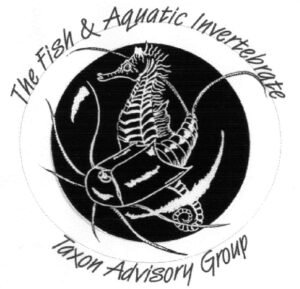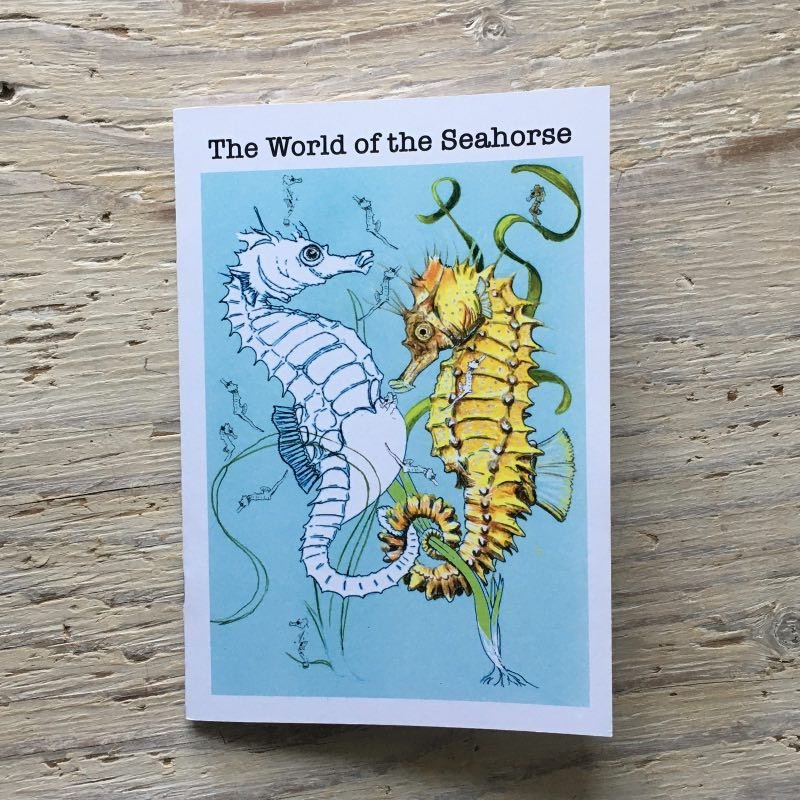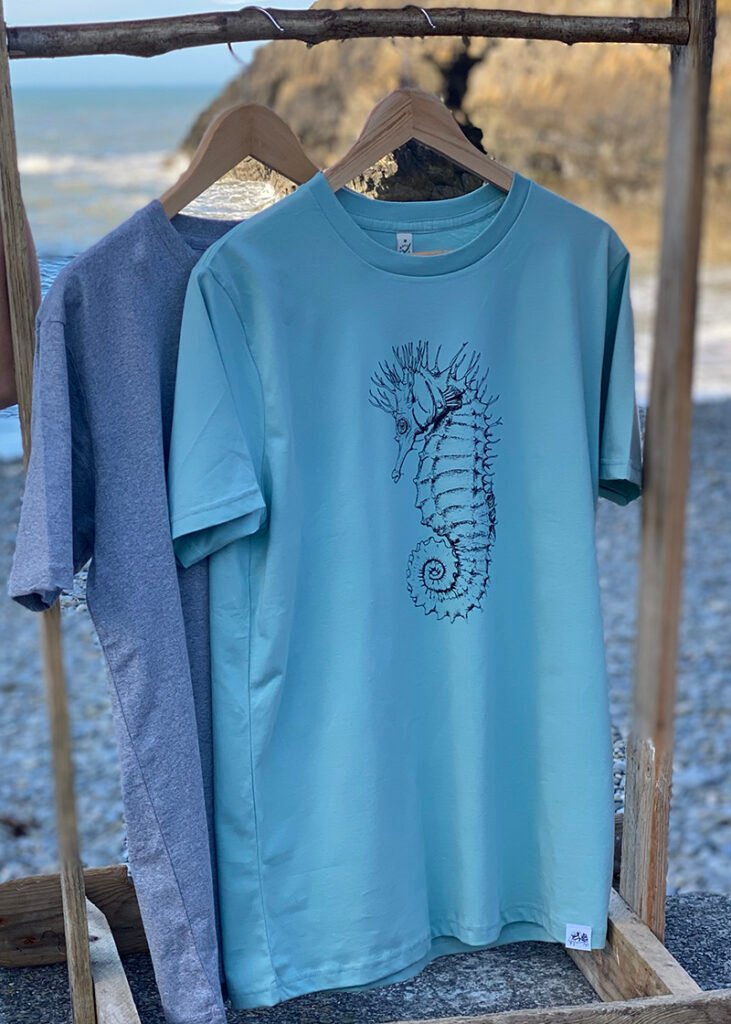Seahorse Conservation
In the early 1990s I helped found the Fish and Aquatic Invertebrate Advisory Group for what was then the Zoo Federation of Britain and Ireland (now BIAZA). I also designed the logo. Among our first project species were seahorses. Not only were they in dire need of conservation attention and awareness, they are such peculiar looking animals, almost magical by their very appearance; mer-horses hinting at a possibility of mermaids and mermen. They seemed a perfect flagship and figurehead for aquatic conservation.

Many zoos and aquaria breed rare seahorses now and have helped diminish collection from the wild. But they are still threatened and still relatively poorly understood, both scientifically and by society, locally and globally. Not everyone knows that seahorses are fishes or where they fit in among fish families and the closer you look, the more interesting it seems to get.
It was as part of the group that I met Neil Garrick Maidment, who has devoted his life to seahorse conservation.
The World of Seahorses
Many of us tend to think of seahorses as exotic, but they breed all round our coast. The two UK species are lucky in that they are legally protected from collection or disturbance. That’s the good news, but seahorses are unlucky in that their protection is very difficult to police. They live in already ‘disturbed’ and polluted waters with their preferred habitat, eel grass beds, severely depleted and damaged.
British Seahorse Species
- Short-snouted Seahorse Hippocampus hippocampus (Linnaeus 1758) (N.E. Atlantic & Mediterranean) 15cm or more
- Long-snouted or Maned Seahorse Hippocampus guttulatus (Cuvier 1829 ) (N.E. Atlantic & Mediterranean) 18cm or more such as the 34cm specimen from Dorset described below
Global Seahorse Trials
Globally, you won’t need telling that the situation is much worse, as seahorses inhabit sheltered, shallow coastal waters. The shallow waters tend to be close the mouths of huge rivers which are very often polluted and are heavily silted from intensive farming inland. The areas can be highly populated leading to disturbance.
Additionally, seahorses are persecuted as accidental bi-catch by fisheries. They are deliberately caught for the pet-trade and barbarically as curios to be sold in ‘shell-shops’ and souvenir retailers. They are also still ground up for folk-medicine. The solutions are often simple and marine conservation areas are proving to be beneficial to neighbouring fisheries.
Seahorse Trust
We have coiled have our tails together with the Seahorse Trust to see if we could raise money for them through sales of T-shirts, notebooks and prints. Many of the world’s seahorse species are threatened and, together we can help them. Our seahorse T-shirt has just had a make over so it feels like a good time to talk about seahorses again.
How you can help seahorses
Wearing your t-shirt loud and proud you can share the facts below. The artwork on the T-shirts is the long-snouted seahorse, the larger of the two British species.
You might choose to join the Seahorse Trust or Dorset Wildlife Trust as a member and support conservation that way. Similarly, the Marine Conservation Society and others are keen to establish more marine reserves where whole assemblages of species, ecosystems, can be protected.
Our seahorse book focuses on the patience of the seahorse. Patience would do the world’s fisheries a lot of good and might mean there are fish for everyone in future, rather than none for anyone!
Sea-life needs our help
Despite massively improved technology, marine fish capture (for food) has been declining since it peaked at the turn of the century. In 2014 it was estimated that, for the first time ever, humans consumed more fish from aquaculture than from the wild. I don’t want to shower doom and gloom on you, these facts come from a fairly hopeful book, Living in the Anthropocene. It estimates that 25% of the fish we eat contains plastics.
In his book ‘Feral’ George Monbiot states:
“ in 1889 the fishing fleet, largely composed of sailing boats, using primitive, homespun gear, reliant on luck rather than on fish-finding technology and all the other sophisticated equipment available today, landed twice the weight of fish as boats working the same sea do today.”
George Monbiot
Conclusion: SEALIFE NEEDS OUR HELP and seahorses make a great figurehead for anyone prepared to divulge the conservation message.
We have worked with founder and Director of the Seahorse Trust, Neil Garrick Maidment for many years on tadpole shrimps and other British species. We were honoured to have a guest blog from him on seahorses, you can read it here >>>
What’s special about seahorses
There are at least 33 species of seahorse worldwide. They are all in the genus Hippocampus like all humans are in the genus: Homo (H. sapiens). Found mostly in the tropics, seahorse species extend into temperate waters to around 50 degrees latitude north and south. The two British seahorse species (Hippocampus hippocampus and H. guttulatus) have been found as far north as the Shetland Islands, which is 60 degrees north.
Seahorse Facts
- Seahorses can change colour like chameleons and octopuses.
- They have 2 skeletons; an exo-skeleton more or less on the outside, and a normal fishy endo-skeleton on the inside.
- Seahorses can live in excess of 15 years.
- Seahorse jaws are fused together to form a tube which can suck in prey from a short distance.
- Seahorses are thought to be one of the most recent and rapidly evolving families in the animal kingdom. Scientists think they evolved from pipefishes (Family Syngnathidae; Sub-family: Syngnathinae) in a sea-grass habitat.
- Seahorse eyes move independently so they can look two ways at once.
- Some seahorses have growths on their skin (called dermal tendrils, filaments or cirri) and can have algae and other marine organisms growing on them.
- All seahorse species are exploited by people for folk-medicines, souvenirs and captive aquaria, as well as being caught by dredgers and trawlers. They are also vulnerable to pollution and coastal erosion. In the United Kingdom, seahorses are legally protected under Schedule 5 of the Wildlife and Countryside Act (1981) but are still vulnerable to harmful marine activities.
- Seahorses, pipefishes, pipehorses and sea-dragons are all members of the family Syngnathidae which is in the order Gasterosteiformes. This order includes cornet fishes, sea moths, snipefishes, trumpetfishes and sticklebacks. We have stickleback T-shirts too! >>>
- Found mostly in eelgrass or seagrass beds, seahorses also live in mangroves and coral reefs. All these habitats are threatened by human activities. In about the last 100 years, seabirds (a big category with about 300 species) have considered to have declined by about 70%. Sharks and great whales by 70 to 90%.
- All seahorses studied so far are monogamous through a breeding cycle and often right through the breeding season. They may form new pairs in subsequent years. During their ‘marriage’ they perform daily courtship rituals.
- Female seahorses produce the eggs which they unload into the pouch of the male where they are fertilised and hatch.
- Small species such as Bargibant’s Pygmy Seahorse, the dwarf seahorse and Denise’s Seahorse (H. bargibanti, H. zosterae and H. denise respectively), often produce less than 50 eggs. Most other species brood 100 to 200 The larger species like the giant pacific seahorse (H. ingens) can produce over 1000 eggs.
Little and Large
There is still so much more to be discovered about seahorses and many species are difficult to identify.
The smallest species seems to be a ‘pygmy seahorse’ called Denise’s seahorse (Hippocampus denise – from Indonesia & northern Australasia). The adults are just 2cm tall (top of coronet to tip of tail). There are two other pygmies: Bargibant’s Pygmy Seahorse (H. bargibanti – from S.E. Asia & Australasia) and the dwarf seahorse (H. Zostreae – from the Gulf of Mexico & Florida) who have been measured at just a few millimetres taller.
At twice the height is Lichtenstein’s Seahorse (H. lichtensteinii – from the Red Sea).
On it goes up to the giant Pacific seahorse (H. ingens – from western tropical America) and the big-bellied or pot-bellied seahorse (H. abdominalis – from S.E. Australia & New Zealand) at over 30cm.
There is a claim that the UK species (H. guttulatus) has recently risen to the status of the world’s largest seahorse after a recent accidental capture. You can see Neil talk about it here >>>.
Seahorse Book
The seahorse storybook to colour is full of seahorse facts for youngsters to learn while they colour.

This picture from the book shows the diversity of sizes

- Denise’s Seahorse Hippocampus denise (Lourie & Randall 2003) (Indonesia & northern Australasia) up to 21mm tall. [ON LITTLE FINGER and on the right in the magnifying glass]
- Bargibant’s Pygmy Seahorse H. bargibanti (Whitley 1970) ( S.E. Asia & Australasia) up to 24mm [ON RING FINGER and central on magnifying glass]
- Dwarf Seahorse H. Zostreae (Jordan & Gilbert 1882) (Gulf of Mexico & Florida) Up to 25mm [LEFT and ON THE THUMB]
- Pacific Giant Seahorse H. ingens (Girard 1859 ) (Western tropical America) Over 30cm [MAIN PICTURE ON HAND, HOLDING MAGNIFYING GLASS]
Donating to the Seahorse Trust
10% of profits from all our seahorse products go straight to the seahorse trust to support their work protecting these beautiful creatures. Thank you for helping us to help them.


